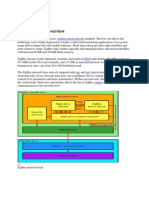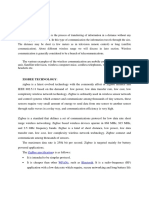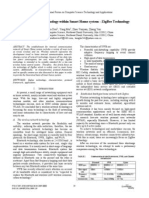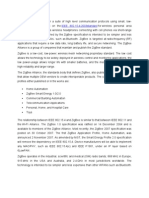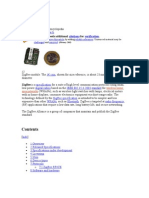0 ratings0% found this document useful (0 votes)
74 viewsZigbee - An Emerging Technology For Future
Zigbee - An Emerging Technology For Future
Uploaded by
Luis Filipe SilvaZigbee is a wireless networking standard used for monitoring and control applications that require low data rates, low power consumption, and long battery life. It uses small, low-power digital radios to allow devices to communicate over long ranges using mesh networking topologies. Compared to Bluetooth, Zigbee has lower data rates but can achieve longer ranges. Its protocols are optimized for low duty cycles and latency, making it suitable for sensor and control applications. Key features include dual radio frequencies, multi-month to multi-year battery life, large device capacity, and ranges from 5-500 meters depending on environment.
Copyright:
Attribution Non-Commercial (BY-NC)
Available Formats
Download as DOCX, PDF, TXT or read online from Scribd
Zigbee - An Emerging Technology For Future
Zigbee - An Emerging Technology For Future
Uploaded by
Luis Filipe Silva0 ratings0% found this document useful (0 votes)
74 views4 pagesZigbee is a wireless networking standard used for monitoring and control applications that require low data rates, low power consumption, and long battery life. It uses small, low-power digital radios to allow devices to communicate over long ranges using mesh networking topologies. Compared to Bluetooth, Zigbee has lower data rates but can achieve longer ranges. Its protocols are optimized for low duty cycles and latency, making it suitable for sensor and control applications. Key features include dual radio frequencies, multi-month to multi-year battery life, large device capacity, and ranges from 5-500 meters depending on environment.
Original Title
Zigbee
Copyright
© Attribution Non-Commercial (BY-NC)
Available Formats
DOCX, PDF, TXT or read online from Scribd
Share this document
Did you find this document useful?
Is this content inappropriate?
Zigbee is a wireless networking standard used for monitoring and control applications that require low data rates, low power consumption, and long battery life. It uses small, low-power digital radios to allow devices to communicate over long ranges using mesh networking topologies. Compared to Bluetooth, Zigbee has lower data rates but can achieve longer ranges. Its protocols are optimized for low duty cycles and latency, making it suitable for sensor and control applications. Key features include dual radio frequencies, multi-month to multi-year battery life, large device capacity, and ranges from 5-500 meters depending on environment.
Copyright:
Attribution Non-Commercial (BY-NC)
Available Formats
Download as DOCX, PDF, TXT or read online from Scribd
Download as docx, pdf, or txt
0 ratings0% found this document useful (0 votes)
74 views4 pagesZigbee - An Emerging Technology For Future
Zigbee - An Emerging Technology For Future
Uploaded by
Luis Filipe SilvaZigbee is a wireless networking standard used for monitoring and control applications that require low data rates, low power consumption, and long battery life. It uses small, low-power digital radios to allow devices to communicate over long ranges using mesh networking topologies. Compared to Bluetooth, Zigbee has lower data rates but can achieve longer ranges. Its protocols are optimized for low duty cycles and latency, making it suitable for sensor and control applications. Key features include dual radio frequencies, multi-month to multi-year battery life, large device capacity, and ranges from 5-500 meters depending on environment.
Copyright:
Attribution Non-Commercial (BY-NC)
Available Formats
Download as DOCX, PDF, TXT or read online from Scribd
Download as docx, pdf, or txt
You are on page 1of 4
Zigbee – An Emerging Technology for Future
This paper presents the feature analysis of zigbee technology based on IEEE 802.15.4 standard. . Due to
characteristics such as low data rate, low price, and low power consumption, ZigBee is expected to be used in
wireless sensor networks for remote monitoring, home control, and industrial automation.
Introduction to Zigbee
ZigBee is the most popular industry wireless mesh networking standard for connecting sensors,instrumentation and
control systems.ZigBee provides several benefits just because it is an industry standard supported by multiple
solution providers.ZigBee solutions are relatively inexpensive because several suppliers have already implemented
ZigBee-based integrated circuits and modules in anticipation of high volumes for a standard solution.ZigBee-based
solutions also offer users independence from any one supplier because one company’s ZigBee networking solution
can be substituted for another’s.ZigBee also offers the potential for interoperability among different suppliers’
products. Finally, in theory, a ZigBee application deployed in a location can use other existing ZigBee nodes in that
location to extend its range and improve its communication reliability.ZigBee delivers solid wireless connectivity
for sensors and actuators in applications that can need the general benefits of mesh networking (i.e., coverage and
reliability) at a reasonable price and tolerate ZigBee’s limitations in mesh size, power consumption, node-to-node
range, and master-oriented operation. ZigBee is actually a network layer protocol standard, but it is designed to
operate over a radio defined by the IEEE 802.15.4 standard for the physical and data link protocol layers.
ZigBee operates in two main modes:
non-beacon mode and beacon mode.
Beacon mode is a fully coordinated
mode in that all the device know when
to coordinate with one another. In this
mode, the network coordinator will
periodically "wake-up" and send out a
beacon to the devices within its
network. This beacon subsequently
wakes up each device, who must
determine if it has any message to
receive. If not, the device returns to
sleep, as will the network coordinator,
once its job is complete. Non-beacon
mode, on the other hand, is less
coordinated, as any device can
communicate with the coordinator at
will. However, this operation can
cause different devices within the
network to interfere with one another,
and the coordinator must always be
awake to listen for signals, thus
requiring more power. In any case,
ZigBee obtains its overall low power
consumption because the majority of
network devices are able to remain inactive over long periods of time.
How zigbee works?
ZigBee basically uses digital radios to allow devices to communicate with one another. A typical ZigBee network
consists of several types of devices. A network coordinator is a device that sets up the network, is aware of all the
nodes within its network, and manages both the information about each node as well as the information that is being
transmitted/received within the network. Every ZigBee network must contain a network coordinator. Other Full
Function Devices (FFD's) may be found in the network, and these devices support all of the 802.15.4 functions.
They can serve as network coordinators, network routers, or as devices that interact with the physical world. The
final device found in these networks is the Reduced Function Device (RFD), which usually only serve as devices
that interact with the physical world.
The figure below introduces the concept of the ZigBee network topology. Several topologies are supported by
ZigBee, including star, mesh, and cluster tree. Star and mesh networking are both shown in the figure above. As
can be seen, star topology is most useful when several end devices are located close together so that they can
communicate with a single router node. That node can then be a part of a larger mesh network that ultimately
communicates with the network coordinator. Mesh networking allows for redundancy in node links, so that if one
node goes down, devices can find an alternative path to communicate with one another.
A comparison between zigbee and bluetooth
The ZigBee standard can operate in the 2.4GHz band or the 868MHz and 915MHz ISM (industrial, scientific and
medical) bands used in Europe and the US respectively It sits below Bluetooth in terms of data rate: 250kbps at
2.4GHz (compared to Bluetooth's 1Mbps) and 20-40kbps in the lower frequency bands.
The operational range is 10-75m, compared to 1Om for Bluetooth (without a power amplifier). One other important
difference between ZigBee and Bluetooth is in how their protocols work. ZigBee's uses a basic master-slave
configuration suited to static star networks of many infrequently used devices that talk via small data packets. This
aspect suits ZigBee to building automation and the control of multiple lights, security sensors and so on. Bluetooth's
protocol is more complex because it's geared towards handling voice, images and file transfers in ad hoc networks.
Bluetooth devices can work peer-to-peer and support scatternets of multiple smaller non-synchronised networks
(piconets). The protocol, however, only allows up to eight slave nodes in a basic master-slave piconet set-up.
ZigBee allows up to 254 nodes. Masters can talk to each other and the number of memory size of the protocol stack
that will lower the mice of ZirBee to around $2 ~ per chip; the ZigBee protocol stack will occupy around 30kwords
of programme space compared to Bluetooths 25fikwords.
The main features of zigbee are:-
Dual PHY (2.4GHz and 868/915 MHz)
Data rates of 250 kbps (@2.4 GHz), 40 kbps (@ 915 MHz), and 20 kbps (@868 MHz)
Optimized for low duty-cycle applications (<0.1%)
CSMA-CA channel access
Yields high throughput and low latency for low duty cycle devices like sensors and controls
Low power (battery life multi-month to years)
Multiple topologies: star, peer-to-peer, mesh
Addressing space of up to:
18,450,000,000,000,000,000 devices (64 bit IEEE address)
65,535 networks
Optional guaranteed time slot for applications requiring low latency
Fully hand-shaked protocol for transfer reliability
Range: 50m typical (5-500m based on environment)
Zigbee has low data rate
The radio channel data rate is a gross indicator of the throughput of the wireless connection, all else being equal. A
higher data rate is not always better, depending on the requirements of the application. For a given transmitter
power, higher data rate can be achieved by sacrificing range – or range can be increased by using a lower radio
channel data rate
Low latency of zigbee
Low latency is another important feature of ZigBee.When a ZigBee device is powered down (all circuitry switched
off apart from a clock running at 32kHz), it can wake up and get a packet across a network connection in around 15
milliseconds. A Bluetooth device in a similar state would take around three seconds to wake up and respond.
According to CCL home,the latency gives you some power consumption advantages and it‘s important for timing-
critical messages. A sensor in an industrial plant needs to get its messages through in milliseconds.
Low power consumption of zigbee
ZigBee’s reliance on a central mains-powered controller minimises the power consumption of the nodes. “They will
only need to turn on when they want to transfer data,” explains Horne. “There is a beacon scheme that the master
uses to define slots. The nodes can then wake up, listen, synchronise to a slot and send data back. It reduces the time
that the outlying nodes need to be on for.”
You might also like
- Caterpillar Cat EC15K EC18K Forklift Lift Trucks Service Repair Manual SNA3EC1-10200 and Up PDFDocument25 pagesCaterpillar Cat EC15K EC18K Forklift Lift Trucks Service Repair Manual SNA3EC1-10200 and Up PDFfjkskkdhsjmdnNo ratings yet
- Technical Overview: Zigbee Is ADocument12 pagesTechnical Overview: Zigbee Is AyouaredeadNo ratings yet
- Technical Overview: Wireless Mesh NetworkDocument13 pagesTechnical Overview: Wireless Mesh NetworkNaveen Telugudesam0% (1)
- ZigbeeDocument9 pagesZigbeelikithavonamalaNo ratings yet
- Zigbee: Origin of WordDocument9 pagesZigbee: Origin of WordRajan VermaNo ratings yet
- ZigBee NewDocument15 pagesZigBee Newlakshmi anusha achantaNo ratings yet
- 1 Coin: Zigbee Is ADocument17 pages1 Coin: Zigbee Is AShrikant JagtapNo ratings yet
- Seminar Report On ZigbeeDocument17 pagesSeminar Report On ZigbeeMansoor ChowdhuryNo ratings yet
- Keywords: Medium Access Control (MAC), Physical Layer (PHY), Wireless Personal Area NetworkingDocument9 pagesKeywords: Medium Access Control (MAC), Physical Layer (PHY), Wireless Personal Area Networkingmnry414No ratings yet
- Zig BeeDocument5 pagesZig BeeYoganathan BNo ratings yet
- XbeeeDocument4 pagesXbeeeHarish PandamaneniNo ratings yet
- Report 1Document8 pagesReport 1Swapnil BangarNo ratings yet
- Zigbee Technology FinalDocument14 pagesZigbee Technology Finalduduck1000No ratings yet
- Seminar Report: Submitted To: Submitted byDocument17 pagesSeminar Report: Submitted To: Submitted byRohan VirmaniNo ratings yet
- Zigbee TutorialDocument9 pagesZigbee TutorialrahulNo ratings yet
- Zigbee TechnologyDocument25 pagesZigbee TechnologyClassic PrintersNo ratings yet
- Zigbee Literature ReviewDocument22 pagesZigbee Literature ReviewBhaskar Rao PNo ratings yet
- Zigbee: Zigbee Is An Ieee 802.15.4-Based Specification For A Suite of High-Level CommunicationDocument6 pagesZigbee: Zigbee Is An Ieee 802.15.4-Based Specification For A Suite of High-Level CommunicationsweetsureshNo ratings yet
- ZigbeeDocument6 pagesZigbeeRavikumar GoliNo ratings yet
- Wireless Communication ZigbeeDocument11 pagesWireless Communication ZigbeeChirag MistryNo ratings yet
- IOT Notes Unit-3 Part-BDocument22 pagesIOT Notes Unit-3 Part-BECE N.V.Satyanarayana MurthyNo ratings yet
- The Networking Technology Within Smart Home System - Zigbee TechnologyDocument5 pagesThe Networking Technology Within Smart Home System - Zigbee Technologyhyj890417No ratings yet
- Gas Management & Disaster System Using ZigBeeDocument6 pagesGas Management & Disaster System Using ZigBeesalmanrashid79No ratings yet
- Zigbee Technology Seminar PresentationDocument10 pagesZigbee Technology Seminar PresentationmithNo ratings yet
- Seminar ReportDocument21 pagesSeminar ReportKunjesh MehtaNo ratings yet
- Fundamentals of IoTDocument24 pagesFundamentals of IoTRohit SaindaneNo ratings yet
- Introduction To Zigbee TechnologyDocument24 pagesIntroduction To Zigbee Technologyveere_arunNo ratings yet
- Unit 3-I M - CombineDocument36 pagesUnit 3-I M - Combinenitin kachhiNo ratings yet
- Unit 3-I MDocument11 pagesUnit 3-I Mnitin kachhiNo ratings yet
- Application of Zigbee Technology in Telecommunication SystemDocument7 pagesApplication of Zigbee Technology in Telecommunication SystemPraveen D JadhavNo ratings yet
- Zigbee Technology: Zigbee Is The Name of A SpecificationDocument11 pagesZigbee Technology: Zigbee Is The Name of A Specificationnamrata_lodhaNo ratings yet
- Iot Project ReportDocument94 pagesIot Project Reportmadhan_M46No ratings yet
- Zigbee TechnologyDocument9 pagesZigbee TechnologyRonald Allan Matubang MadlaNo ratings yet
- What Is Zigbee ?Document24 pagesWhat Is Zigbee ?Bhanu PriyaNo ratings yet
- Zig BeeDocument21 pagesZig BeesatishreddicNo ratings yet
- New Seminar On ZigbeeDocument24 pagesNew Seminar On ZigbeeMansoor ChowdhuryNo ratings yet
- Zig BeeDocument21 pagesZig BeesatishreddicNo ratings yet
- Zigbee: From Wikipedia, The Free EncyclopediaDocument7 pagesZigbee: From Wikipedia, The Free EncyclopediaShruti VazeNo ratings yet
- Zigbee Technology Cse Ieee Seminar Topic Idea AbstractDocument10 pagesZigbee Technology Cse Ieee Seminar Topic Idea AbstractVidya Hiremath100% (1)
- Compusoft, 2 (12), 422-426 PDFDocument5 pagesCompusoft, 2 (12), 422-426 PDFIjact EditorNo ratings yet
- Is A Specification For A Suite of High Level Communication Protocols Using Small, LowDocument3 pagesIs A Specification For A Suite of High Level Communication Protocols Using Small, LowTejas TailorNo ratings yet
- Literature Survey On ZigBee / IEEE 802.15.4 System ImplementationDocument7 pagesLiterature Survey On ZigBee / IEEE 802.15.4 System ImplementationEditor IJTSRDNo ratings yet
- Zigbee TechnologyDocument20 pagesZigbee TechnologyVigneshInfotechNo ratings yet
- Zigbee Technology IJERTCONV3IS10001Document4 pagesZigbee Technology IJERTCONV3IS10001bhuvaneshv274No ratings yet
- Zigbee ENDocument18 pagesZigbee ENkarakuloNo ratings yet
- Zigbee Second PartDocument22 pagesZigbee Second PartgrandhiramamurthyNo ratings yet
- Computer Networks Assignment-2 Wireless Networks: BY: P.Vishnu Priya 311518104053 Iii Be-CseDocument11 pagesComputer Networks Assignment-2 Wireless Networks: BY: P.Vishnu Priya 311518104053 Iii Be-CseVishnu priyaNo ratings yet
- Zigbee: A Review: Gurpreet Singh, Raghav Bhardwaj, Karamjeet Singh, Sahil MehlaDocument4 pagesZigbee: A Review: Gurpreet Singh, Raghav Bhardwaj, Karamjeet Singh, Sahil MehlaEs LimNo ratings yet
- Zigbee ModuleDocument10 pagesZigbee ModuleSV TechnologiesNo ratings yet
- Zig BeeDocument27 pagesZig BeeRicha SharmaNo ratings yet
- Zigbee TechnologyDocument9 pagesZigbee Technologyarjun royalNo ratings yet
- Zigbee TechnologyDocument20 pagesZigbee TechnologyChikkapriyankaNo ratings yet
- ZigbeeDocument65 pagesZigbeevinay999100% (4)
- Wireless Automation Using Zigbee Technology: Presentation-IDocument14 pagesWireless Automation Using Zigbee Technology: Presentation-IVijay EmmanuelNo ratings yet
- 02 02 2023 - Cse3009 Iot BK ZigbeeDocument43 pages02 02 2023 - Cse3009 Iot BK ZigbeeMann PandyaNo ratings yet
- CompTIA Network+ (N10-009) Study Guide: Comprehensive Exam Preparation and Key Concepts for Network ProfessionalsFrom EverandCompTIA Network+ (N10-009) Study Guide: Comprehensive Exam Preparation and Key Concepts for Network ProfessionalsNo ratings yet
- Cisco Certified Network Associate (CCNA) and Cisco Certified Network Professional (CCNP): Mastering Network Automation and Programmability Study GuideFrom EverandCisco Certified Network Associate (CCNA) and Cisco Certified Network Professional (CCNP): Mastering Network Automation and Programmability Study GuideNo ratings yet
- Versatile Routing and Services with BGP: Understanding and Implementing BGP in SR-OSFrom EverandVersatile Routing and Services with BGP: Understanding and Implementing BGP in SR-OSNo ratings yet
- Huawei Big Data-Based Anti-APT SolutionDocument4 pagesHuawei Big Data-Based Anti-APT SolutionLuis Filipe SilvaNo ratings yet
- Build Beautiful Native Apps in Record Time With Flutter - Eduardo Telaya PDFDocument42 pagesBuild Beautiful Native Apps in Record Time With Flutter - Eduardo Telaya PDFLuis Filipe SilvaNo ratings yet
- 2010 11 18 - SubstationAutomationSystems byGinQuesadaDocument98 pages2010 11 18 - SubstationAutomationSystems byGinQuesadaLuis Filipe SilvaNo ratings yet
- Satellite Communications: CSC 490: Wireless Networking Author: Michael CharlesDocument27 pagesSatellite Communications: CSC 490: Wireless Networking Author: Michael CharlespraveennallavellyNo ratings yet
- 1s4t2en - 30 9 16 - TPD32 EvDocument502 pages1s4t2en - 30 9 16 - TPD32 EvKrittaphak Hacheyram100% (1)
- TomatoesDocument6 pagesTomatoesNataly Cruz VenturinaNo ratings yet
- User Manual: Casting Simulation SoftwareDocument51 pagesUser Manual: Casting Simulation SoftwareasifNo ratings yet
- Fears Lessen That Invasive Fungi Will Completely Wipe Out Hawaii's Iconic Native TreeDocument5 pagesFears Lessen That Invasive Fungi Will Completely Wipe Out Hawaii's Iconic Native TreeIgnatia KurniatiNo ratings yet
- AVE General 2015Document398 pagesAVE General 2015Diego RodriguezNo ratings yet
- Correct Gnosticism and The Ordo Templi OrientisDocument24 pagesCorrect Gnosticism and The Ordo Templi OrientisChrystianRevellesNo ratings yet
- Mini Project Synopsis - PDF (3) .PDF (10) - MergedDocument5 pagesMini Project Synopsis - PDF (3) .PDF (10) - MergedANSH SINGHAL JEG221693No ratings yet
- Sixth GradeDocument2 pagesSixth Gradeأبو أسامة أحمدNo ratings yet
- HW2 PDFDocument13 pagesHW2 PDFMuzamil ShahNo ratings yet
- Nord KockDocument12 pagesNord KockMarcoNo ratings yet
- Bushberg 2013Document1 pageBushberg 2013Aul Reyvan AuliaNo ratings yet
- CRTDocument11 pagesCRTJessica CarterNo ratings yet
- Buchholz Relays PRINCIPLESDocument9 pagesBuchholz Relays PRINCIPLESBui Vanluong100% (1)
- Practical ADMDocument23 pagesPractical ADMShaikh AshrafNo ratings yet
- Construction Management Plan: Project: Yarra One Apartments 16-22 Claremont Street, South Yarra 3141Document44 pagesConstruction Management Plan: Project: Yarra One Apartments 16-22 Claremont Street, South Yarra 3141Jay-ar CalucinNo ratings yet
- The Viola/Jones Face DetectorDocument21 pagesThe Viola/Jones Face DetectorApril MccormickNo ratings yet
- 6comparative Lexicon of Lsi West BengalDocument81 pages6comparative Lexicon of Lsi West BengalAyanifyNo ratings yet
- CH1&2 Homework AnswersDocument5 pagesCH1&2 Homework AnswersGabriel Aaron DionneNo ratings yet
- Alonso SedanoDocument15 pagesAlonso SedanoJose Luis Ponce CovarrubiasNo ratings yet
- Lockridge DeviceDocument20 pagesLockridge Deviceartleader50% (2)
- Rope PriceDocument4 pagesRope Priceyt9cxg4mvpNo ratings yet
- EE24Document38 pagesEE24fiskar327No ratings yet
- Ic FabricationDocument29 pagesIc FabricationAkvir Kaur100% (1)
- Albis Broschuere TelecommunicationsDocument7 pagesAlbis Broschuere TelecommunicationsRoger PrunedaNo ratings yet
- Ethnic Houses in The Philippines HISTARCDocument5 pagesEthnic Houses in The Philippines HISTARCJohn Laurence Crucena VillaNo ratings yet
- A Study On Impact of Internship On Regular Studies of Undergraduate StudentsDocument10 pagesA Study On Impact of Internship On Regular Studies of Undergraduate StudentsSujan pandeyNo ratings yet
- Boiler Tube LeakagesDocument20 pagesBoiler Tube LeakagesParmeshwar Nath Tripathi100% (2)
- 05 PilotProjectGridScaleBESS EGATDocument34 pages05 PilotProjectGridScaleBESS EGATPongsakorn NakkharaNo ratings yet
- Understanding Factors Affecting The Shelf Life of Food ProductsDocument2 pagesUnderstanding Factors Affecting The Shelf Life of Food ProductsSidNo ratings yet




